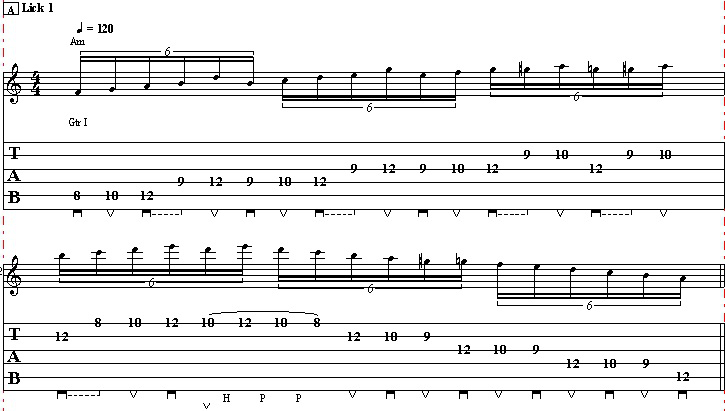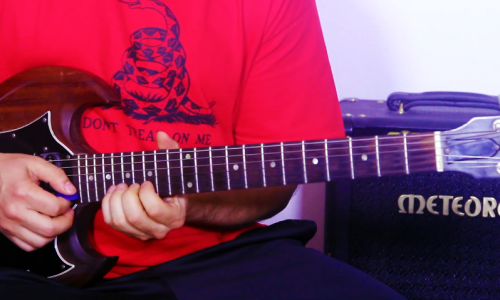Hey, how’s it going this is Sean Daniel with Guitar Control. I’m going to show you an absolute lady killer song called “Breakeven” by The Script. It’s super easy, and it sounds a little more impressive than it actually is. It’s only 4 chords, and a lot of it you’re anchored in one spot.
[ninja-popup ID=715]
Click on the Tabs button to follow the chords and tabs.
It’s really the same four chords, and it’s like the same chord progression, but it’s actually flipped, which is kind of a cool thing that might open up some songwriting ideas for you, and just a very easy way to start on memorizing other chord progressions. Basically the song sounds like this, Until it changes.
So, first thing you may notice, capo is on the third fret. So all these chords that we’re going to talk about are going to be relative to the capo. So the first one, is E minor. But, we’re going to make it an E minor seven, and specifically, I want to do it like this. This may not be like an E minor that you’ve played before, but it gets the job done.
And the great thing about this entire thing, if you already noticed it from watching the play through, is I kept my fingers kind of positioned in the same way. There’s a couple different ways you can do this. But first thing we’re going to do for all these chord voicing, is to take your ring finger and lock it down on the third fret relative to the capo on the B string.
Now, all these chords are going to be built with your ring finger right there. You don’t have to move. So, the E minor, E minor seven technically, is going to look like this. Pointer finger’s on the second fret of the A string, middle finger’s on the second fret of the D string.
Now, this can be reach for some people. There’s actually an Intro, played with my pinky locked down. It doesn’t really matter. You only need these other two fingers to move around the rest of the way. So whatever’s more comfortable for you and make sure one of your fingers is on the D string right here. So this E minor shape is going to go to this D major shape.
Now this is maybe an interesting way to play the D major if you haven’t tried this before, but it’s really easy. Just take the E minor and then you spread those fingers apart where your pointer finger goes up a string and your middle finger goes down a string. So now you have two on the low E string, open A, open D, and two on the G string. This is really a D major chord, but it’s a low D major chord.
One of the weaknesses of the D major chord, like this, is you only get the bottom four strings or the highest four strings and they actually has a volume discrepancy with maybe some of the bigger open chords like G or D. To get a beefier D major, grabbed this technique called inversion, where the root note is not the lowest note. So this is an F sharp note.
So E to D. We’re going to talk about the strumming in just a second. And now we’re going to go to G right here, middle finger, third fret on the low E string. Second fret on the A string, pointer finger. Then again your ring finger stays the same. And then for C, we’re just going to move your middle finger and pointer finger one string higher, okay. So technically this is a Cadd9 because this note relative to the capo we’ve been holding down is a D note and a C major chord with a nine in it, it was regular C major. And then with the D in it, it’s technically called a Cadd9. All together we have A minor seven to D then G to C. So now when we put the strumming pattern on it.
Okay, it sounds really musical. It sounds like a great song. Which it is. Give it up for The Script. You’ve got to love it. So it’s really a little bit different than just like a 1, 2, 3, 4, 5, 6, 3, 4, 1, 2, 3, 4, 1, 2, 3, and 4. Like an eight count for a song. You can play it like that. That’s totally fine. Sometimes it’s easier to break things down into just straight down strokes if you’re just starting out.
But I think a really cool thing you can do is actually break that eight count into a three count and a five count. So what that means is the first chord gets three beats and the next chord gets five and that kind of gives a little more lively strumming. So like 1, 2, 3, 1, 2, 3, 4, 5, 1, 2, 3, 1, 2, 3, 4, and 5.
And then if we look at this group of four cords, just knocked something over. And then if we look at this group of four chords as pairs of chords, right? The E to the D, they split that bar. They split the eight count into a three and five instead of four and four. Okay. Most musical progressions are going to be symmetrical in some way. So once you kind of asymmetry calyzed these chords, it sounds a little bit different. It sounds kind of cool because kind of pushing that chord progression forward, right? So we’re splitting that E minor and the D up into a three and five.
1, 2, 3, 1, 2, 3, 4, 5.
Same thing with the G and the C. 1, 2, 3, 1, 2, 3, 4, 5. 1, 2, 3, 1, 2, 3, 4, 5. 1, 2, 3, 1, 2, 3, 4, 5. 1, 2 and 3, 1, 2 and 3, 4, 5. 1, 2 and 3, 1, 2 and 3, 4, 5.
The reason I started saying the word and in some of those counts is the direction of the pick. All the numbers are going to be down strokes and the word and is going to be an up stroke.
1, 2 and 3, 1, 2 and 3, 4, 5, 1, 2 and 3, 1, 2 and 3, 4, 5, 1, 2 and 3 and 1, 2 and 3, 4, 5, 1, 2 and 3 and 1, 2 and 3, and 4, and 5. A million different variations as you can do of that, but just make sure you get that 3 and the 5. Other [inaudible 00:06:27] you can do is really heavily palm mute it, because this is technically the verse of the song.
And the reason it’s actually nice to palm mute the verses a lot, one, it makes it easier to sing, volume wise, because you’re kind of choking the volume of the guitar. Two is because you can add a dynamic into the chorus of the song, which is like the big part of the song. Usually at the most, the most important part of pop song. I’m not going to totally sign off on that comment, but it’s true when it comes to pop music and this is definitely pop music, is we’re going to do the reverse of those four chords. So remember the verse was the E, D, G, C. So if we played that backwards it would be C, G, D, E. So it’s the same thing. We’re just going to flip it.
Now you can click the link below to get the chords on here and you can see the chord chart. It’s really just like E minor seven, D. Sometimes also too, this inversion of a D major. You can see this as a slash chord with a slash and an F sharp. That F sharp just means it’s in the root note, right. So the chorus of this is C, G, D, E minor. C to G to D to E minor. And that’s it.
So now that palm muting for the verse became really important because in the verse, if your palm muting it … By the time you get to the chorus … It just has a lot more energy.
One way to kind of build a lot of energy in your playing is by palm muting the verses and then just going big on the choruses, right.
Now, the last thing I want to talk about is because we have a very, there’s four different chords in kind of the same area and especially because these are open chords with the capo on the third fret. These open chords are really good opportunities to practice your hammer on and your pull offs. Right? So let’s talk about what that means with the chorus chords instead of just going C to G to D to E, we could go like …
I realize it’s kind of like a subtle thing that you can add that kind of spices up your playing a lot. So [inaudible 00:08:58] Cadd9, that’s a heavier pointer finger. Just work on maybe doing a hammer on. So the first three count, one, two and three and one, two and three and hammer on.
You have those two extra counts in that five count. You can just use your pointer finger to kind of hammer on and off on that G chord. 1, 2, and 3 and 1, 2 and 3 and 4, 5, 1, 2 and 3 and 1, 2 and 3 and 4 and 5. Right that E minor.
The nice thing about how the ear is used to kind of playing symmetrically all the time when you have like a three and a five count, like what this is, we could have the first three match up with the second three of the next chord and then we have those two extra beats to kind of maybe just do something fancy. And then a lot of times this will take place when the singer isn’t singing over this. Whether you’re singing along with it, which I definitely urge you to try. Again, absolutely the killer of a song. 1, 2 and 3 and 1, 2 and 3, whatever, 4 and 5. 1, 2 and 3 and 1, 2 and 3 and 4 and 5.
Those last two beats, you can do a lot with, whether it’s abandoning the shape, kind of going into a scale. Which if you’re interested in on that kind of playing, we’ve got a ton of other videos on the Guitar Control Channel that talk more about scales and inflections and how you can kind of like incorporate all that cool stuff into your chord playing. So definitely make sure to click on any of the surrounding videos here by myself, other great instructors. And again, this is just a real easy one. Anybody can play it at any level. It’s a good challenge because you can kind of use an easy framework of chords to work on maybe some more technical aspects of your playing with the palm muting and the hammer ons and stuff. But again, easy one. You’re silly not to have this in your repertoire because it’s so easy to learn, like you just learned it in 11 minutes. So definitely let us know what you guys want to see more of in the comment section and we’ll get back to you as soon as you can. Thanks a lot.
Click here to get Sean Daniel’s first instructional guitar package. GO!!!




